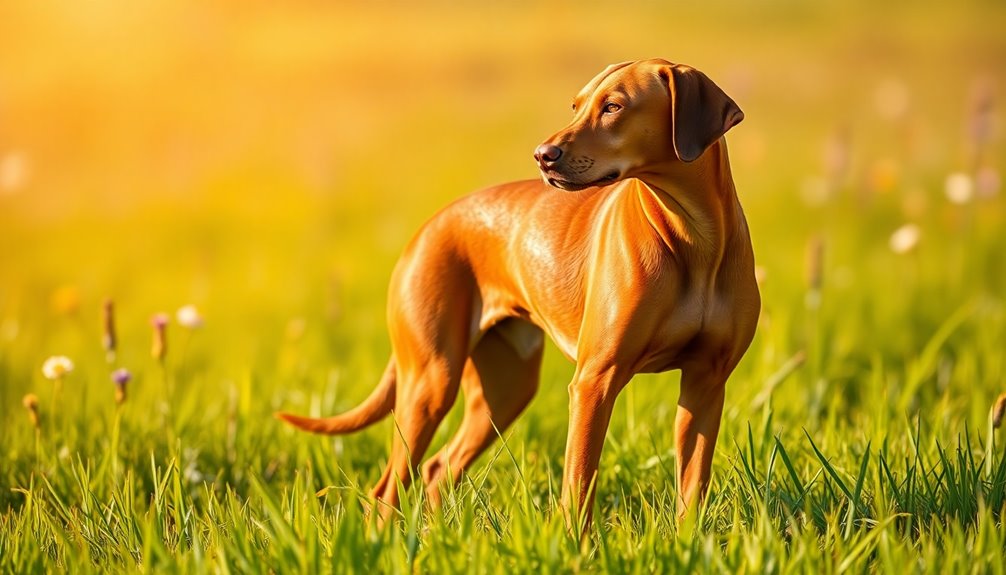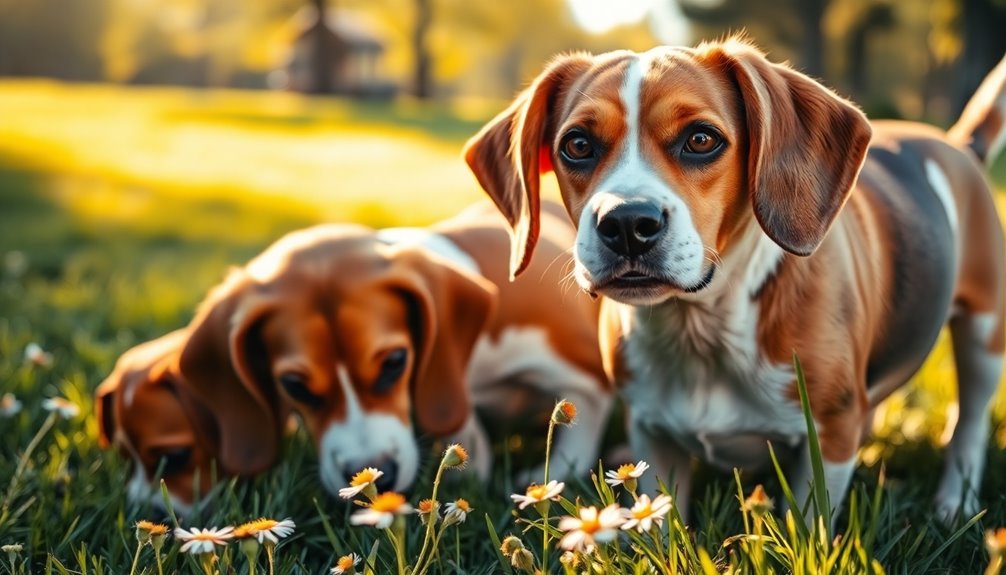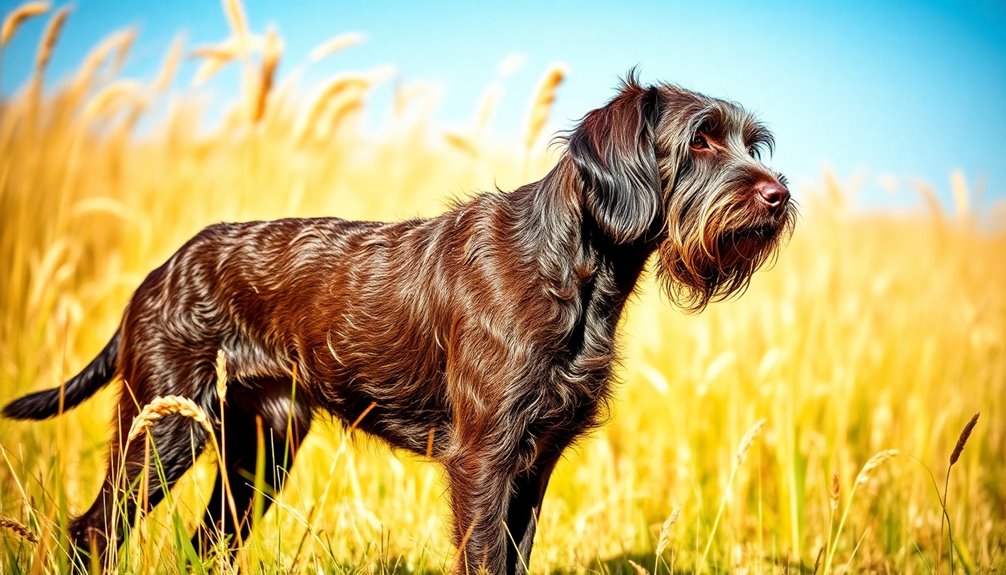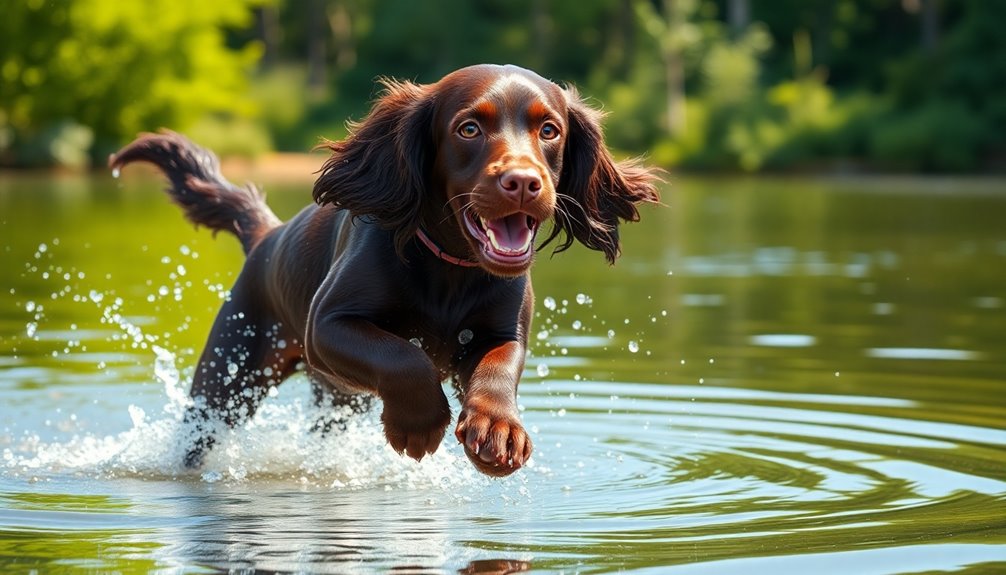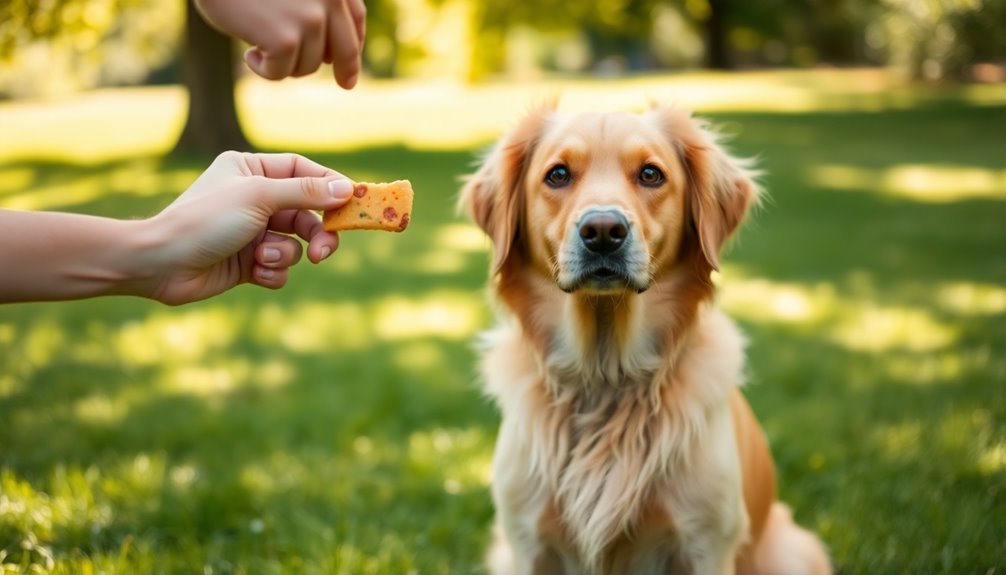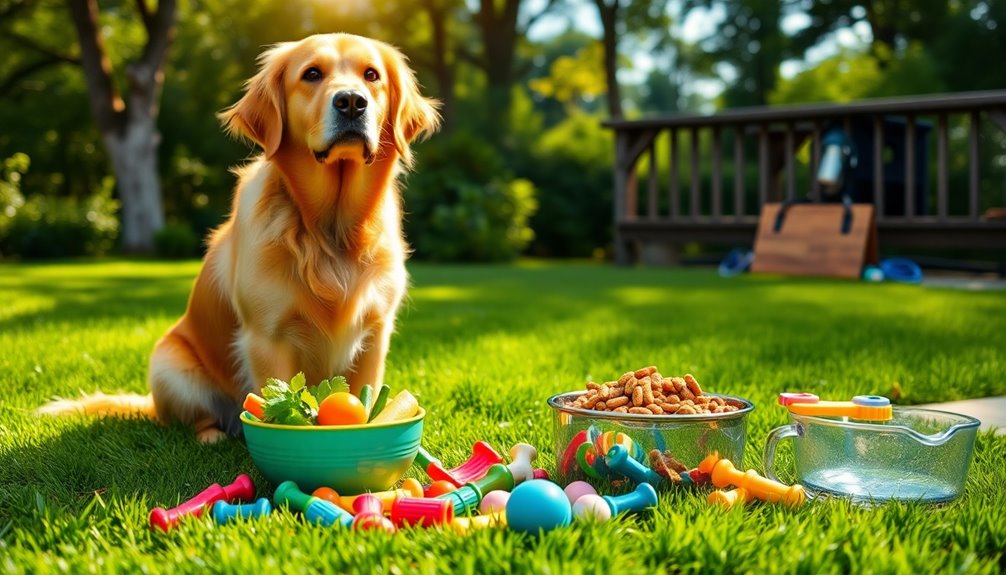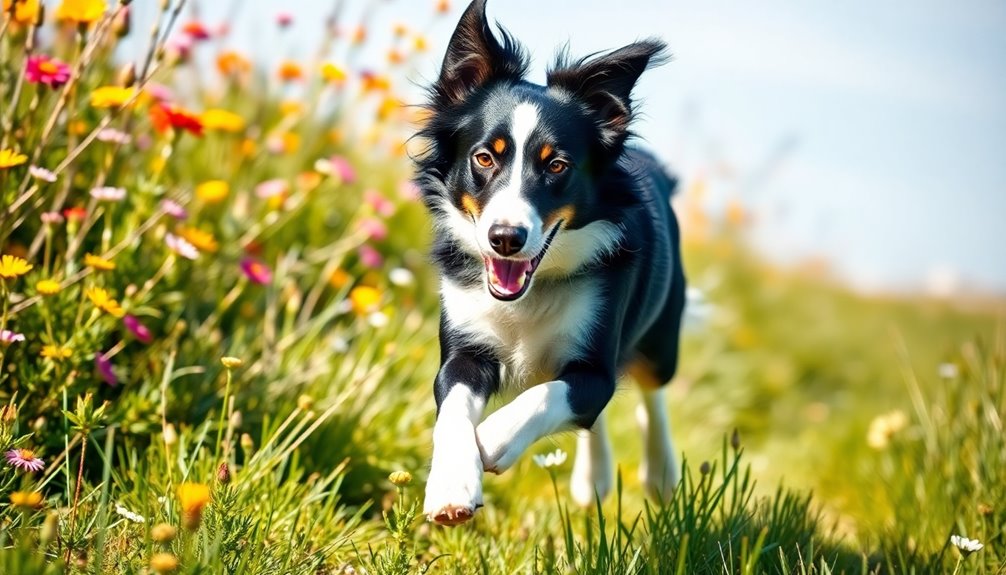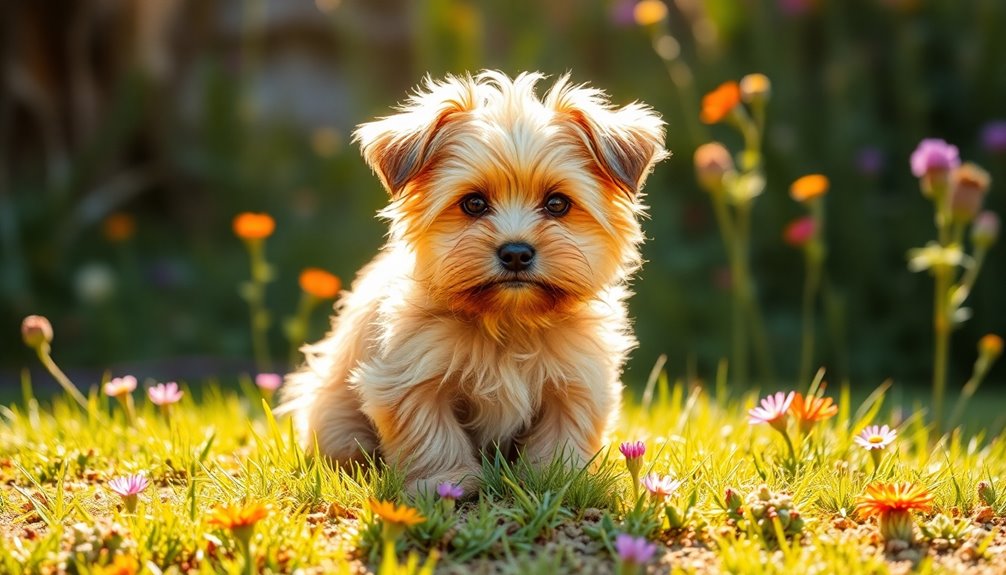The Victorian Bulldog combines the classic charm of bulldogs with modern improvements for better health and temperament. You'll appreciate their sturdy, stocky build and affectionate nature, making them great family pets. With an average height of 17-19 inches and a weight of 55-75 pounds, they're gentle and playful, thriving on companionship. Regular grooming and moderate daily exercise keep them happy and healthy. They adapt well to various living conditions, but they do need a cool environment due to their sensitivity to temperature. If you're curious about what makes them unique and how to care for them, there's more to uncover!
Key Takeaways
- The Victorian Bulldog combines classic bulldog features with a healthier physique, thanks to selective breeding focusing on improved respiratory function.
- Developed in the 1980s, this breed aims to revive the nostalgic traits of bulldogs from the Victorian era while enhancing overall health.
- With a loyal and affectionate temperament, Victorian Bulldogs are excellent family companions, adapting well to various lifestyles and forming strong bonds.
- Their short, stocky build and diverse coat colors, excluding black, maintain the traditional bulldog appearance while promoting a modern, refined look.
- Regular exercise and proper nutrition are essential for maintaining their health, focusing on quality food and moderate daily activity to prevent obesity.
Introduction
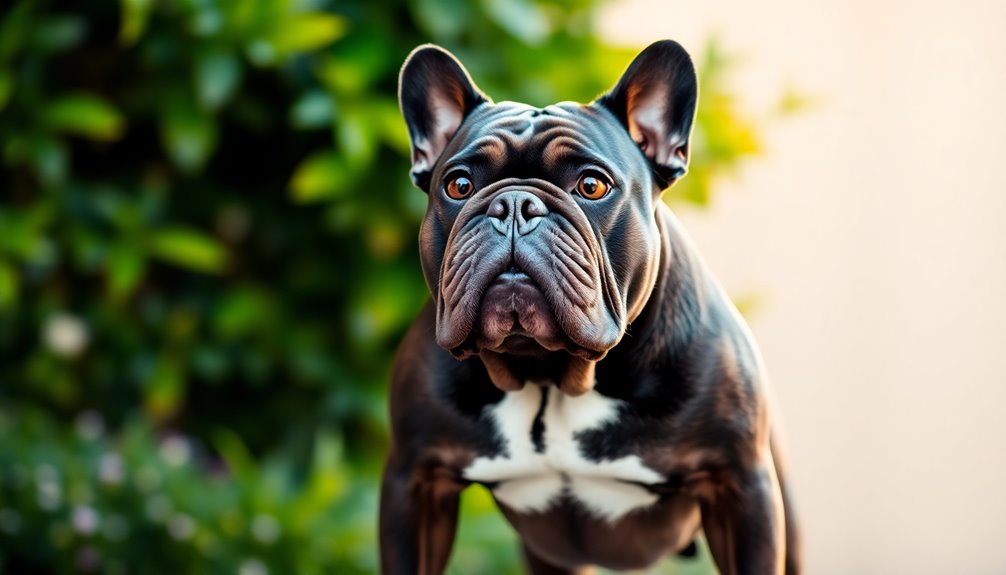
The Victorian Bulldog is a unique breed that combines strength and elegance, making it a favorite among dog lovers. Standing about 19 inches tall and weighing between 55 to 75 pounds, these medium to large dogs have a large head and thick bones that don't compromise their vigor.
Their broad muzzle and short face are designed for breathing, ensuring they remain active and playful.
Temperament-wise, you'll find them to be loyal and reliable, embodying the classic bulldog personality. They're gentle and affectionate, often seeking your attention and forming strong bonds with family, including children and other pets. However, they can be scrappy with unfamiliar dogs if they don't receive proper leadership.
Health care is essential; they're prone to drooling and snoring, and you'll need to clean their wrinkly faces regularly. They require moderate exercise and mental stimulation daily, adapting well to moderate climates. These dogs are especially sensitive to heat and need to be monitored closely during warm weather.
Training is a breeze since they're intelligent and eager to please, but consistency is key to overcoming their occasional stubbornness. With proper socialization, you'll help them behave well around strangers and other dogs, making them wonderful companions.
History and Origin
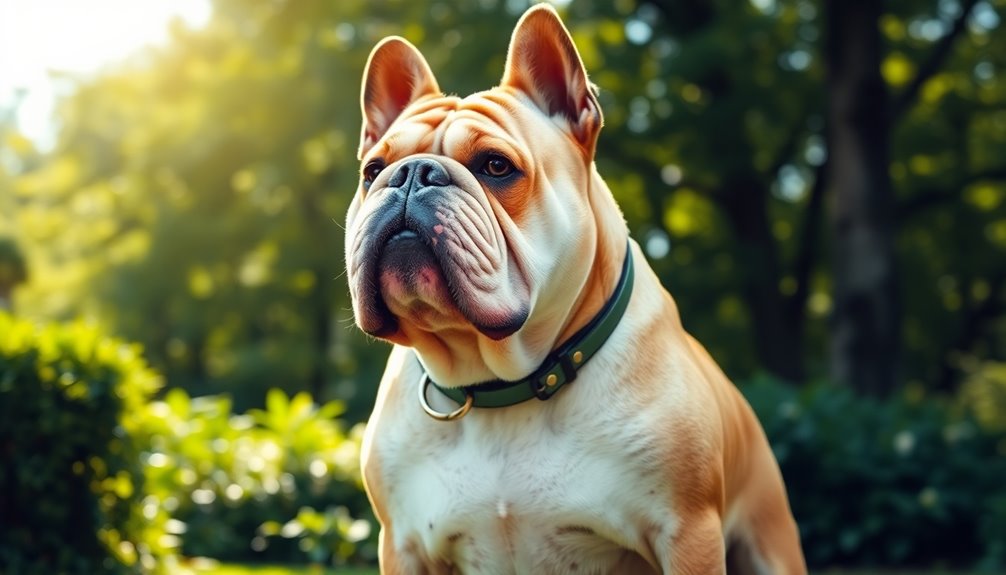
You might be surprised to learn that the Victorian Bulldog's ancestors were once involved in the brutal sport of bull-baiting in England during the 1700s and 1800s. This cruel pastime, which focused on immobilizing bulls, led to the near extinction of the breed when it was outlawed in 1835. However, in the 1980s, Ken Mollett took it upon himself to recreate a healthier version of this iconic dog, giving rise to the Victorian Bulldog we know today. The breed's historical use in bull-baiting has shaped its confident and loyal temperament, making it a unique companion for modern families.
Where and when the breed originated
Originating in the 1980s, the Victorian Bulldog was developed by Ken Mollett with the intent of creating a healthier version of the bulldog breed. Mollett, along with his brother Derek and Graham Woods, initially worked on this project, but he later continued alone. In 1988, he founded the Victorian Bulldog Society to promote this new breed.
Mollett aimed to recreate bulldogs reminiscent of the Victorian era, which were overshadowed by health issues in modern English Bulldogs. To achieve this, he primarily crossed English Bulldogs with Bull Terriers for improved health and athleticism. Additionally, Bullmastiffs contributed strength and a healthier build, while Staffordshire Bull Terriers helped enhance the breed's athletic capabilities. Some breeding programs also included Dogue de Bordeaux.
The Victorian Bulldog stands out with its longer snout, athletic build, and shallower wrinkles compared to modern counterparts. This breed seeks not only to restore the original bulldog's physical traits but also to eliminate the health problems associated with them. Proper upbringing is crucial for maintaining the breed's lovable and social temperament.
Though still relatively rare, it has gained recognition, especially in the United States, marking a significant step in bulldog development.
Bull-Baiting and Protection Work
As bulldogs evolved through selective breeding, their history is deeply intertwined with the brutal sport of bull-baiting. This gruesome spectacle involved pitting dogs against bulls tied to iron stakes, a practice that dates back to at least 1209 during King John's reign.
In ancient civilizations, including those of the Egyptians, Greeks, and Romans, similar activities were common. In England, bull-baiting gained popularity in the Middle Ages, with the belief that it made bull meat more tender.
The dogs, specifically the now-extinct Old English Bulldog, were bred to seize the bull's snout, the animal's most sensitive area. The objective was to pin the bull by biting and holding onto its nose or neck, often with multiple dogs taking turns. This intense competition led to the bulldog's stocky build and powerful jaws. Today, the Victorian Bulldog has been developed to be a healthier variant of the traditional English Bulldog.
However, when bull-baiting was outlawed by the Cruelty to Animals Act of 1835, the breed's numbers dwindled. Many Old English Bulldogs were mixed with Terriers for dog fighting, while modern Bulldogs emerged as gentler companions, their ferocity selectively bred out for a more amiable temperament.
Physical Characteristics
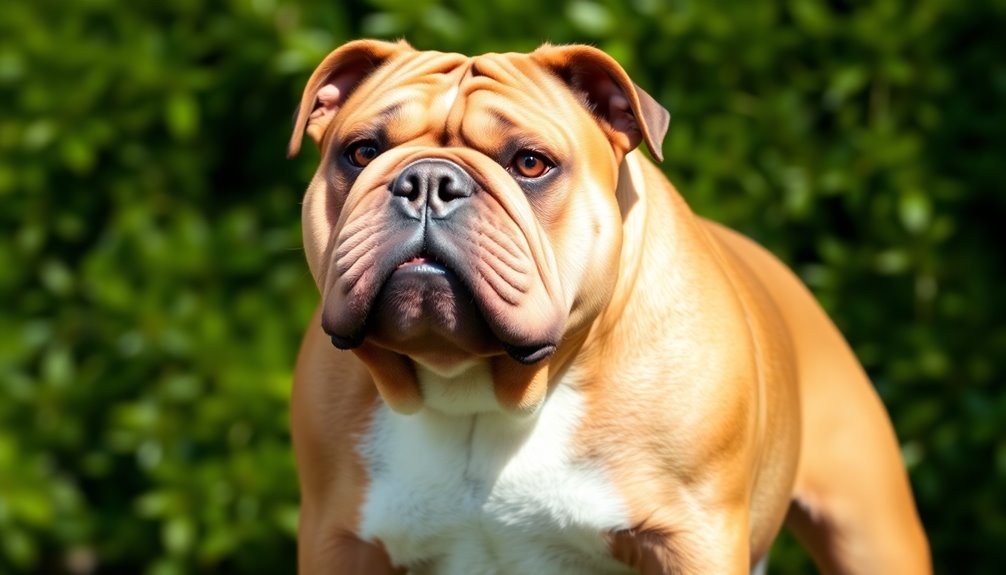
The Victorian Bulldog has a short, stocky build that gives it a powerful appearance. You'll notice its solid weight and muscular limbs, which contribute to its athletic stance. This breed sports a smooth, dense coat in various colors, requiring regular grooming to maintain its sleek look. Additionally, the Victorian Bulldog's average weight ranges from 70 to 75 lbs for males and 55 to 65 lbs for females, emphasizing its robust physique.
Size, weight, and coat details
Victorian Bulldogs are medium to large dogs, with males standing between 17 to 19 inches tall and females ranging from 16 to 19 inches. Both males and females typically reach their adult height within 1 to 2 years.
In terms of weight, males usually weigh between 70 to 75 pounds, while females weigh between 55 to 65 pounds. Weight can vary slightly based on breeding standards, but proper nutrition is key to maintaining optimal weight as they mature.
Their coat is short, smooth, and very dense, requiring regular brushing to manage shedding. Although they don't shed excessively, expect two annual blowouts when you might notice more fur around the house.
The coat feels silky to the touch and comes in a variety of colors, including white, red, fawn, brindle, and fallow. Notably, Victorian Bulldogs should never be black or possess combinations that include black. Additionally, their breeding program aims to ensure no common health issues arise, promoting a healthier breed overall.
The combination of their size, weight, and striking coat colors contributes to their distinct and appealing appearance, making them a wonderful choice for dog lovers who appreciate both beauty and temperament in their pets.
Short, Stocky Build
With their impressive size and striking coat, these dogs also boast a short, stocky build that reflects their Bulldog heritage.
You'll notice their muscular structure, characteristic of the breed, giving them an athletic vigor that's hard to miss. Their symmetrical body features hindquarters slightly higher than the foreparts, but everything remains proportionate.
The Victorian Bulldog's large head is in harmony with its body, showcasing a short face that balances breathing needs without compromising aesthetics.
They sport a broad muzzle that turns upwards, complemented by well-defined, rounded cheeks. You'll appreciate their large, black nostrils and eyes that sit low, wide apart, avoiding a bulging or sunken look.
Their facial features include a broad muzzle with a good wrinkle, but don't worry—it's not overly loose.
Canines are set wide and large, enhancing their robust charm. This breed is lively and playful, ready to engage in activities, yet their stubbed tail and straight feet indicate a sturdy build.
Though they're active, they don't demand excessive exercise, making them perfect companions for indoor life, provided they enjoy daily walks. Additionally, the Victorian Bulldog has an average life expectancy of about 10-14 years, which gives families ample time to create lasting memories together.
Temperament and Personality
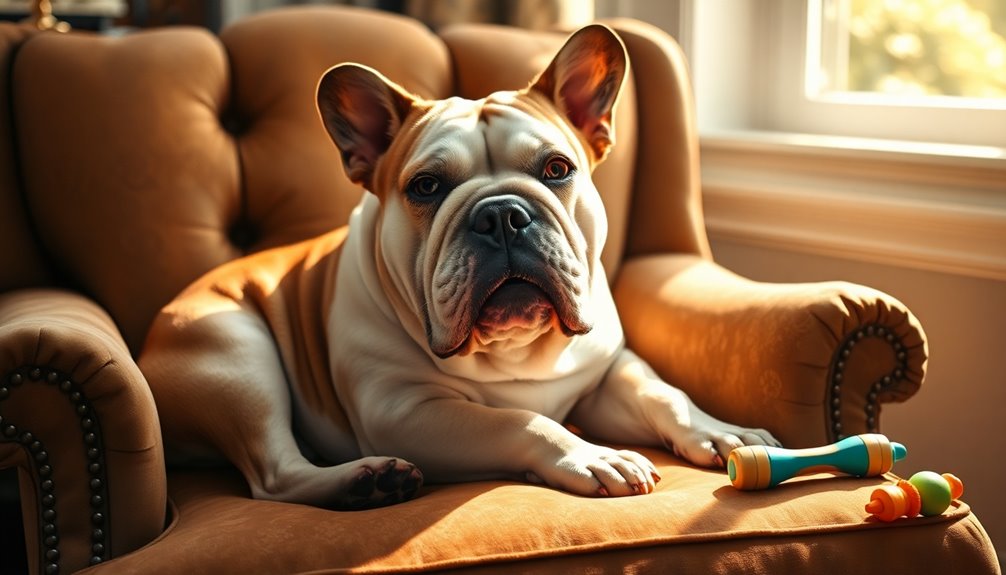
The Victorian Bulldog's playful and protective nature makes it a fantastic companion for families and individuals alike. You'll find that they get along well with kids and other pets, bringing a lively joy to your home. Their affectionate demeanor and loyalty ensure they're not just pets, but beloved family members. With a high-energy level, they thrive on regular exercise and mental stimulation, making playtime an essential part of their daily routine.
Playful and Protective Nature
Many Victorian Bulldogs exhibit a delightful blend of playfulness and protective instincts that make them exceptional companions.
These lively pups are always up for an adventure or a cozy snuggle, bringing infectious joy as they frolic around. You'll find them enjoying simple pleasures like lickmats loaded with treats, showcasing their robust build and patience that make them excellent playmates. While they've a lazy temperament, they still engage in active play in short bursts, ensuring you never have a dull moment. Additionally, their incredible sense of smell allows them to engage in exciting activities like scent games, stimulating their minds while having fun.
Their protective instincts kick in when it comes to family safety. With a courageous heart, they'll see off any intruder, even though they've a gentle nature. Initially, they might be wary of strangers and unfamiliar dogs, reflecting their guarding abilities. Proper leadership is essential to curb any scrappy behavior with other dogs.
These loyal companions thrive on human affection and are known for their dependability. They seek out your attention and love every bit of it, making them wonderful partners for anyone willing to invest time and care.
With a Victorian Bulldog, you'll find a playful and protective friend who's ready to enrich your life.
Suitability for families, individuals, or other pets
Victorian Bulldogs make excellent companions for families, individuals, and even other pets due to their adaptable temperament and affectionate nature.
They're gentle and patient with children, making them great playmates, especially for older kids. While they thrive in family settings, they do require supervision around very young children. Regular exercise needs contribute to their overall well-being, helping to ensure they remain healthy and happy.
Their laid-back attitude means they can fit well into various lifestyles, whether you're active or more relaxed.
For individuals, these dogs crave companionship and thrive on human interaction, so they're not the best choice for those who are away for long periods.
Their intelligence makes them responsive to reward-based training, but a bit of patience is necessary due to their stubborn streak.
When it comes to other pets, Victorian Bulldogs can coexist peacefully with them if socialized correctly.
With regular exercise and attention, they can adapt to apartment living without a problem.
Just keep in mind that they're not hypoallergenic, and they may drool or snore.
Health and Lifespan
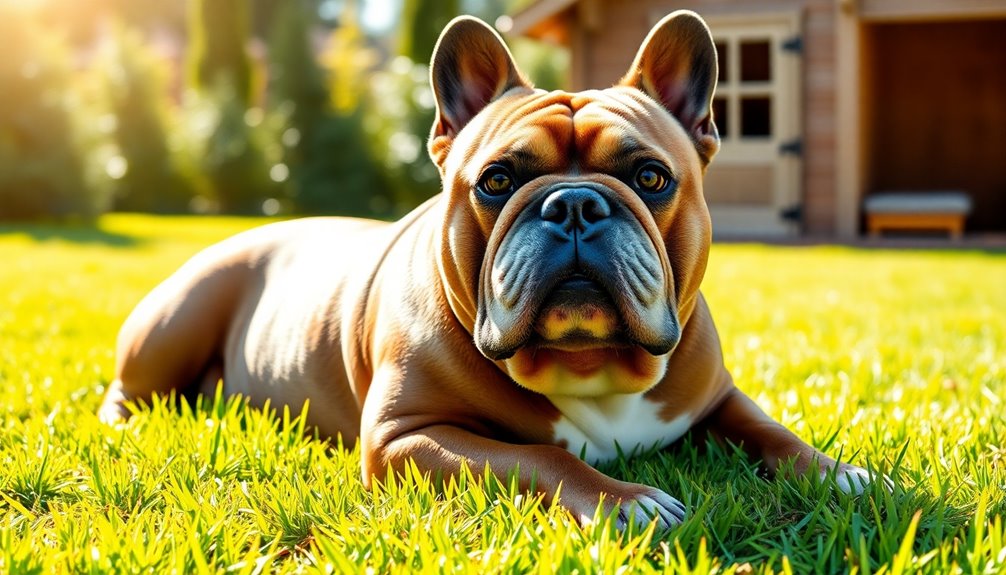
When you consider the Victorian Bulldog's health and lifespan, you'll find that they typically live between 12 to 14 years. However, they're prone to certain health concerns like cherry eyes and obesity that can impact their quality of life. To keep your Bulldog thriving, regular exercise and a balanced diet are essential. Additionally, the average lifespan of Victorian Bulldogs is longer than that of English Bulldogs, which typically average around 9 years.
Typical lifespan of the breed
The typical lifespan of a Victorian Bulldog ranges from 10 to 14 years, making it a relatively long-lived breed compared to its English counterpart. While some sources suggest a lifespan of 10 to 12 years, others indicate that 12 to 14 years is more common. This breed benefits from a breeding program aimed at improving health and longevity, which contributes to its longer lifespan compared to English Bulldogs, who average around 9 years.
To ensure your Victorian Bulldog lives a full, healthy life, proper care is essential. Regular exercise helps maintain their health, while a high-quality diet and careful monitoring of food intake play significant roles in their longevity. Additionally, moderate climates are preferable due to their temperature sensitivity. Socialization is also crucial for their overall well-being and behavior.
Moreover, the Victorian Bulldog's improved respiratory function helps them adapt better to various environments, further supporting their health. Don't forget the importance of regular veterinary checkups to catch any potential issues early. With appropriate care, you can help your Victorian Bulldog thrive well into their golden years, enjoying the companionship and joy they bring to your life.
Common health concerns or genetic predispositions
Caring for a Victorian Bulldog involves being aware of common health concerns and genetic predispositions that can affect their well-being. These dogs are prone to skin issues like infections, eczema, and hot spots. You should also watch for Cherry Eye, a bulging red bump that can affect their vision. Allergies are another concern, particularly food sensitivities that may lead to gassiness and skin reactions.
Obesity is common in this breed, often resulting from overfeeding or lack of exercise, which can lead to additional health problems. Their brachycephalic nature means they've difficulty breathing, especially in hot weather. Joint problems like hip and elbow dysplasia, along with arthritis, can cause pain and limit their mobility. Additionally, genetic diversity loss can exacerbate these health issues, as it has been linked to various congenital diseases in related breeds.
Additionally, Victorian Bulldogs are at risk for heart disease and may have increased anesthetic risks due to their unique anatomy. Regular veterinary check-ups are essential for monitoring heart health and catching potential issues early.
They may also face other genetic predispositions, including thyroid problems and various cancers. Being proactive about their health will help ensure your Victorian Bulldog lives a happy and fulfilling life.
Tips for maintaining health and wellness
Maintaining your Victorian Bulldog's health and wellness requires a proactive approach that encompasses regular veterinary check-ups, a balanced diet, and consistent exercise. Schedule vet visits to monitor their overall health, and consult about specific dietary needs. Feed your bulldog high-quality dog food, tailored to their age, size, and activity level, divided into two meals to prevent bloating. Always provide fresh water, especially in hot weather or after exercise. Additionally, incorporating cilantro in moderation can provide beneficial vitamins for your dog's health.
Daily walks and playtime are essential for keeping your dog active and preventing obesity, a common issue for this breed. A few short walks throughout the day, combined with interactive play sessions, can meet their physical needs. Additionally, be aware that moderate climates are best, as they struggle to cool down in heat.
Regular grooming is vital too. Brush your bulldog weekly to maintain skin health, clean their facial wrinkles, trim nails, and clean ears to prevent infections. Bathing once a month or as needed helps avoid skin irritation. Lastly, brushing their teeth two to three times a week can prevent dental disease, ensuring a long and healthy life of 10 to 14 years for your beloved companion.
Care Requirements
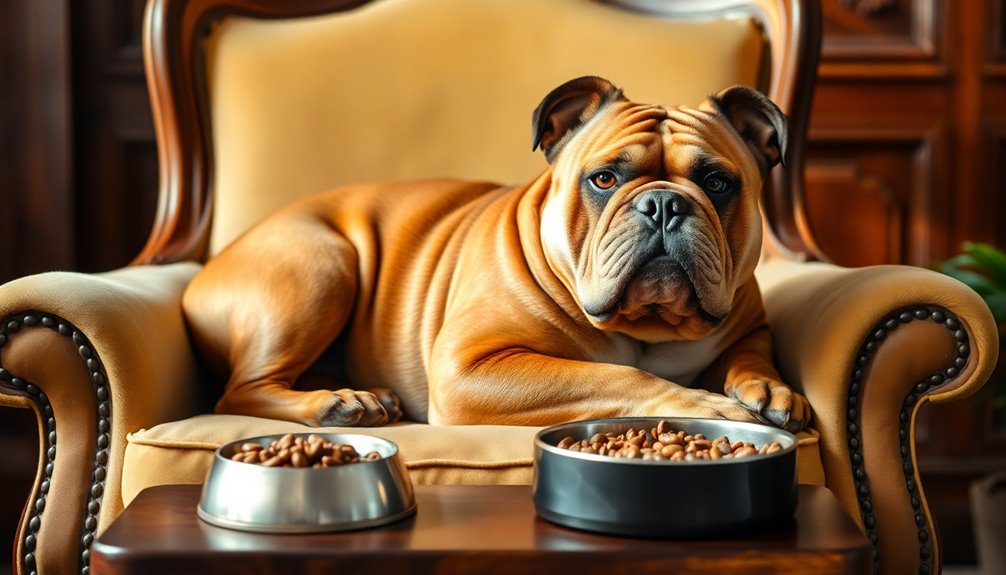
Caring for your Victorian Bulldog involves understanding their grooming, exercise, and dietary needs.
You won't need to spend a lot of time on grooming, but regular exercise is crucial to keep their energy levels in check. Regular exercise contributes to their overall happiness and well-being, making it an essential part of their care routine. Additionally, feeding them a balanced diet will support their overall health and well-being.
Minimal Grooming Required
The Victorian Bulldog's grooming routine is straightforward, making it an appealing choice for busy pet owners.
You'll only need to brush your dog 2-3 times a week using a firm or soft bristle brush to loosen hairs and minimize moderate shedding. Expect two annual 'blow outs' where shedding peaks, but regular brushing helps manage this.
Bathing should be reserved for when it's truly necessary, as frequent baths can strip essential skin oils. Daily face wipes with a damp cloth clean inside the wrinkles and prevent skin infections. Since this breed is prone to skin issues, consider using a medicated shampoo and supplements to maintain skin health. Regular grooming practices also help prevent common health issues related to skin and coat conditions.
Dental care is crucial; aim to brush your dog's teeth daily or at least 2-3 times a week. This practice prevents plaque buildup and keeps gums healthy.
Monthly nail trims and weekly ear checks are essential to prevent infections. Lastly, be prepared for drool cleanup, as this is a common trait among bulldogs.
With these simple tasks, you'll ensure your Victorian Bulldog remains clean and healthy without a demanding grooming schedule.
Exercise requirements and energy levels
Grooming isn't the only aspect of keeping your Victorian Bulldog happy and healthy; regular exercise plays a vital role, too.
These dogs need moderate exercise, about 20-30 minutes each day, ideally split into shorter sessions—think two 10-minute walks. Strenuous activities should be limited to 10-15 minutes to prevent exhaustion.
Walking is the most recommended form of exercise, but don't hesitate to mix it up! Playing fetch, tug-of-war, or light wrestling can help release their energy. You can even set up agility courses using household items for added fun. Additionally, it's important to provide puppy pads indoors for when they need a quick bathroom break during playtime.
While Victorian Bulldogs are generally less prone to breathing issues than other bulldog breeds, managing their exercise is crucial.
Keep an eye on the weather to avoid heatstroke, and always prioritize their comfort. Regular activity not only enhances their bone and organ health but also helps alleviate hyperactivity and promotes mental stimulation.
Integrate exercise into your daily routine—walk to a dog-friendly cafe or consider a dog walking service if you're pressed for time.
Consistency is key to ensuring your Victorian Bulldog stays happy and healthy!
Feeding tips and diet recommendations
To keep your Victorian Bulldog thriving, focus on providing a balanced diet that meets their nutritional needs. Aim for around 1,000 calories daily, which translates to about 1 to 2 cups of high-quality dog food split into two meals to prevent bloating. Always check the food packet for specific guidelines based on your dog's weight.
Your dog's diet should be rich in proteins, fats, carbohydrates, vitamins, and minerals. Include high-quality protein sources like chicken, beef, fish, and eggs. Fats are essential for energy and coat health, but balance is key to prevent obesity. American Bulldogs are known for their stocky, muscular build, which means they require a diet that supports their strong physique.
Carbohydrates should come from whole grains, fruits, and vegetables to support energy and digestion. Opt for dog food with real meat as the primary ingredient and natural sources of glucosamine for joint health. Look for products rich in omega-6 fatty acids and essential vitamins and minerals.
Avoid foods with excessive fillers or artificial additives, as digestibility is crucial for proper nutrition. Always consult your veterinarian for specific dietary concerns and remember to provide fresh water, especially during warmer months or after exercise.
Maintaining an ideal weight is vital for your bulldog's joint health and overall well-being.
Training and Socialization
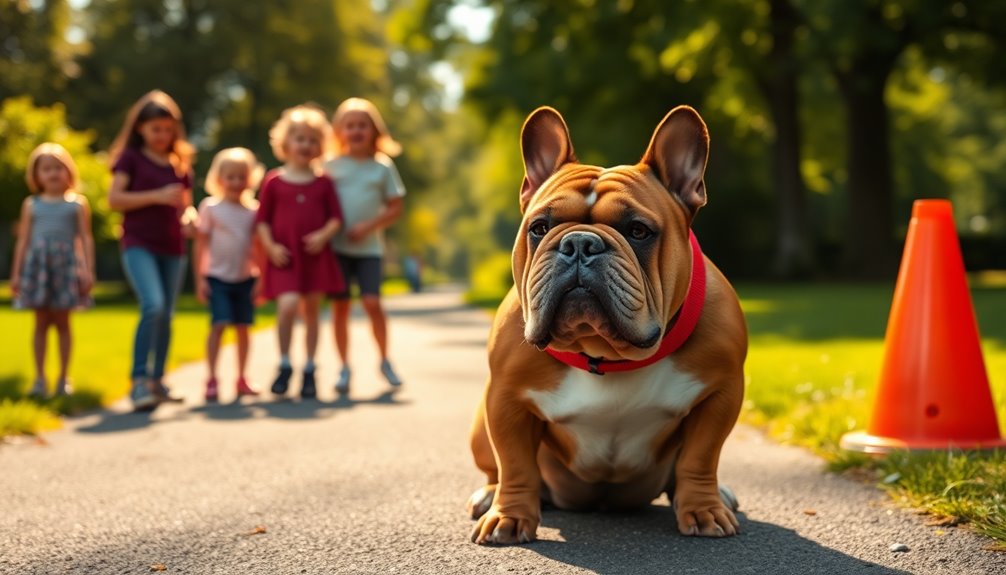
Training your Victorian Bulldog can be a rewarding experience, as they're moderately responsive to commands. Introduce your dog to new friends gradually to ensure they feel comfortable and confident. When walking, keep an eye on leash pulling, and use positive reinforcement to encourage better behavior. It's also important to focus on socialization with dogs during their growth stage to promote well-rounded behavior.
Moderately Responsive to Commands
When you engage with a Victorian Bulldog, you'll find that they respond moderately well to commands, making effective training crucial for a harmonious relationship. Reward-based training works best for these dogs. Using food-based rewards or clicker training can significantly enhance their learning experience, as they thrive on positive reinforcement.
To achieve the best results, it's important to start early in their training journey, as young dogs show higher adaptability and receptiveness to learning.
Avoid force-based or dominance training, as this can lead to resistance. Start with basic commands like "Sit," "Stay," and "Leave-It," which are essential for everyday interactions. Teaching the "Drop It" command is also important to prevent resource guarding.
If your dog jumps up, teach alternative behaviors like sitting to replace unwanted actions. Consistency and patience are especially key when working with adult dogs, so keep your training sessions enjoyable and engaging.
Mental stimulation is vital, so incorporate new tricks and behaviors to keep your Victorian Bulldog interested. Remember, they're social creatures that appreciate quality interactions with humans and other dogs.
Gradual Introductions to New Friends
Introducing your Victorian Bulldog to new friends is a vital step in their social development. Start socialization between 3 to 14 weeks of age, when they're most receptive to new experiences.
Expose your pup to various people, including children and adults of different ethnicities, to build their comfort around diverse individuals. Early exposure aids in developing positive social behavior in Bulldogs.
Introduce them gradually to different sounds, like vacuum cleaners and doorbells, to help them acclimate to various noises.
When it comes to other animals, begin with calm, well-behaved dogs in controlled environments. Keep interactions short at first, using positive reinforcement to reward calm behavior.
Take your Victorian Bulldog on outings to parks and busy streets to familiarize them with new environments. Gradually introduce different surfaces like grass and tile, ensuring they don't feel overwhelmed.
Monitor all interactions closely to ensure safety and comfort, especially when children are involved. Teach kids how to approach and interact gently with your dog.
Enrolling in puppy training classes can provide a structured environment for socialization and skill-building, setting your Victorian Bulldog up for friendly, confident interactions in the future.
Leash Pulling During Walks
Leash pulling can be a frustrating challenge for Victorian Bulldog owners during walks, but with the right approach, you can train your pup to walk calmly by your side.
Start early by introducing the leash and collar around eight weeks old. Begin practicing indoors to get your puppy used to the equipment without distractions.
Use positive reinforcement—reward your dog with treats and praise when they walk correctly on the leash. Gradually progress from short indoor sessions to outdoor walks, increasing duration and distance as your pup improves.
If they pull, simply stop moving until the leash is slack. This teaches them that pulling doesn't get them anywhere. A well-fitted collar, such as a prong collar, can help ensure that pressure is distributed evenly, making training more effective.
Consider using a prong collar or a properly fitted harness to help manage pulling effectively. Make sure your dog is familiar with the equipment to avoid discomfort.
To keep their attention, create unpredictable walking patterns by changing directions and stopping often.
Lastly, ensure your Victorian Bulldog gets enough physical and mental stimulation to reduce excess energy, which often leads to pulling.
Consistency in training is key, so keep practicing regularly to reinforce good behavior.
Ideal Living Environment
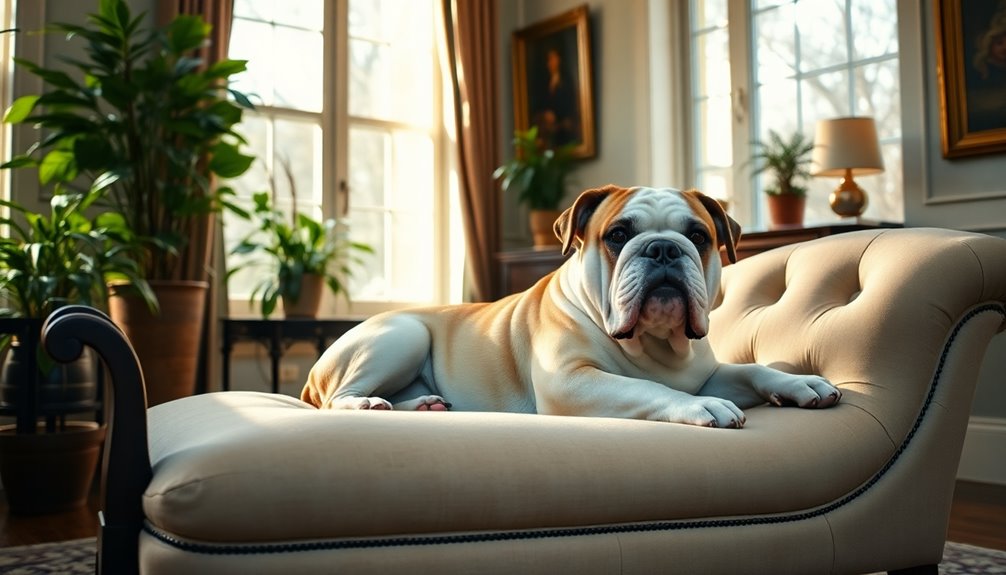
If you're considering a Victorian Bulldog, a house with a fenced yard is ideal for their comfort and safety.
They handle humidity well but need to be protected from extreme heat and cold.
Creating a cozy environment ensures your pup stays happy and healthy while enjoying their space.
House With a Fenced Yard
A house with a fenced yard is an ideal living environment for a Victorian Bulldog, providing the perfect balance of space and security. This breed doesn't require a vast area; a small yard suffices for their movement and exercise needs.
A securely fenced yard ensures your dog can roam safely, preventing any wandering or encounters with wildlife. Daily walks of 20-30 minutes are essential, but having a yard allows your bulldog to engage in spontaneous playtime.
Ensure the yard is free from hazards and has adequate supervision to keep your dog safe. Training your bulldog on a leash is crucial to avoid accidents, especially if your yard is near busy roads.
Socialization is vital, so providing a safe space for your bulldog to interact with family and other pets will enhance their emotional well-being. Regular off-leash time and mentally stimulating games will keep your bulldog happy and calm.
Humidity Tolerance and Comfort
Humidity can pose significant challenges for Victorian Bulldogs, primarily due to their brachycephalic structure. Their short snouts and narrow breathing passages make it hard for them to handle high humidity, which can lead to breathing difficulties. It's essential to keep them in air-conditioned environments, especially in humid climates, to avoid overheating. High humidity can also increase the risk of skin infections due to their skin folds, so regular cleaning of these areas is crucial.
The ideal temperature range for your Victorian Bulldog is between 50°F and 80°F. Anything below 50°F can be too cold, while temperatures above 80°F may lead to overheating. Temperature sensitivity can vary by individual dog, so be mindful of their tolerance; conditions that make you sweat are likely too extreme for them.
Direct sunlight exposure should be limited, as they can quickly overheat or get sunburned. Avoid exercising your bulldog in hot weather to prevent serious health issues.
Instead, provide them with a cool, well-ventilated indoor environment, where they can relax comfortably. Regular grooming and monitoring for signs of heat distress will help ensure their health and happiness.
Unique Facial Wrinkles
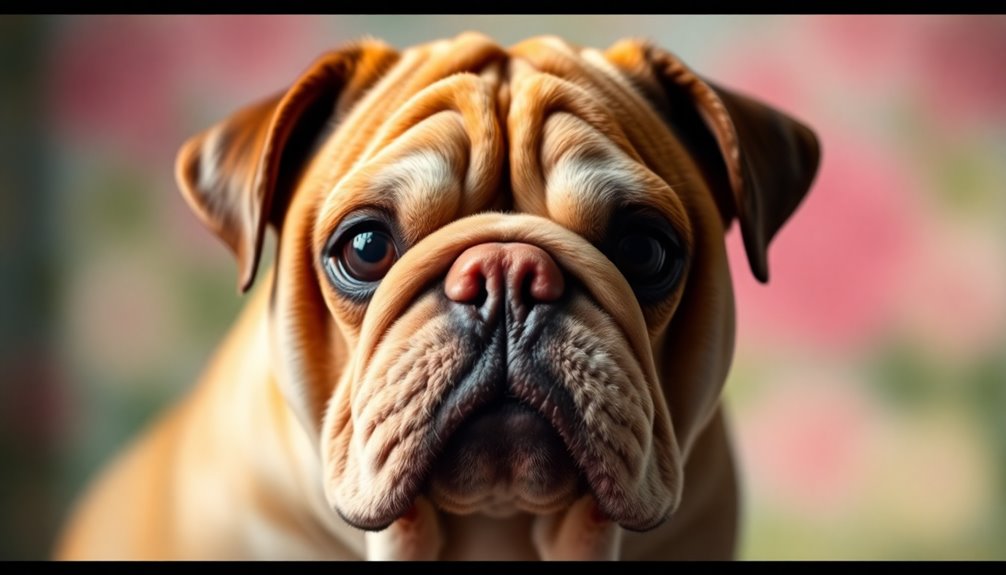
When you look at a Victorian Bulldog, you can't help but notice its unique facial wrinkles and distinctive underbite. These features not only give them a charming appearance but also make them popular in cartoons and media. The wrinkles provide protection during their historical fights, showcasing how their appearance has evolved while retaining elements of their past. Let's explore how these traits contribute to their persona and appeal.
Distinctive Underbite Characteristic
The distinctive underbite of Victorian Bulldogs is one of their most recognizable traits, capturing attention with its unique aesthetic appeal. This feature originates from their English Bulldog ancestors, bred for bull-baiting, where a strong grip was essential.
Although bull-baiting was outlawed in 1835, breeders continued to favor dogs with underbites, cementing this characteristic in the breed.
Anatomically, the brachycephalic structure of Victorian Bulldogs contributes to their underbite. Here, the lower jaw tends to be longer than the upper jaw, causing a misalignment that defines their look. Jaw misalignment is a common occurrence in brachycephalic breeds, leading to various dental issues.
The broad muzzle and short face further emphasize this trait, making it a hallmark of the breed.
While the underbite was once a functional trait, it has become an aesthetic standard for Victorian Bulldogs today. Many breed purists consider it desirable, although some dogs mightn't exhibit a pronounced underbite.
Regardless, this distinctive feature helps you identify bulldog breeds at a glance.
It's essential to care for this area, as the underbite can lead to skin issues and infections. Regular cleaning and hygiene practices can help keep your Victorian Bulldog healthy and happy.
Victorian Bulldogs in Popular Cartoons
Featuring prominently in animated series, Victorian Bulldogs are often depicted with unique facial wrinkles that enhance their charm and expressiveness. Characters like "Hector" and "Spike" from Looney Tunes, along with "Marc Antony," showcase these delightful features, making them iconic in cartoon history. Their wrinkled faces and expressive eyes contribute significantly to their comedic roles and loyal personalities.
In "Tom and Jerry," Spike serves as a protective figure, humorously confronting Tom while occasionally caring for his puppy, "Tyke." This dynamic highlights the bulldog's fierce yet loving nature, a common theme across various cartoons. Additionally, these dogs are known for their short muzzles, which add to their unique appearance and charm.
Other characters, like "Butch" from MGM cartoons and "Francis" from Oliver & Company, also reflect the bulldog's distinctive appearance through their memorable antics.
The combination of short, sturdy limbs, broad muzzles, and expressive facial reactions makes Victorian Bulldogs a favorite among audiences. Their playful yet loyal disposition often leads to humorous situations, contrasting their tough looks with gentle moments.
This cultural impact helps shape public perception of bulldogs, solidifying their place in animated storytelling.
Is This Breed Family-Friendly?
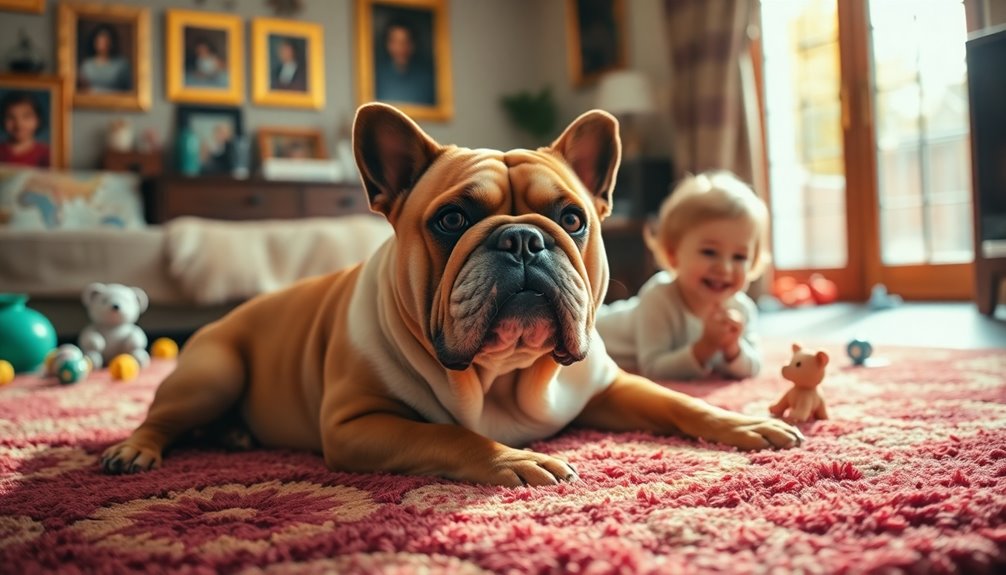
If you're looking for a family-friendly dog, the Victorian Bulldog might just be the perfect fit.
They thrive in active households and enjoy being part of family activities, making them great companions for both kids and adults. Just remember, they do need regular exercise and a commitment to their training for a harmonious life together. Their protective nature also makes them suitable around children, providing an added layer of comfort for families. Additionally, they often exhibit strong loyalty to their owners, enhancing the bond within the family.
Ideal for Active Families
Victorian Bulldogs make excellent companions for active families, thanks to their gentle and patient nature with children of all ages. They're perfect playmates for both young kids and older ones, offering a loving and loyal presence in your home. These dogs thrive in family environments where they receive plenty of attention and companionship, adapting well whether you live in an apartment or a house with a yard. Regular outings to dog-friendly parks can enhance their adaptability and confidence.
Despite their sometimes grumpy appearance, Victorian Bulldogs are happy, hearty, and enjoy snuggling with you after a fun day of play. They do require proper socialization to get along with other pets, but with early exposure to various sights and sounds, they'll grow into well-rounded dogs. Their protective instincts make them great guardians of your family, alerting you with a bark if something seems off, yet they remain calm and composed.
Keep in mind that they can experience separation anxiety if left alone for too long, so it's essential to engage them in regular activities and training. Interestingly, the breed's temperament has shifted from aggressive to gentle through selective breeding, making them even more suitable for family life. With their low grooming needs and adaptability, Victorian Bulldogs truly fit well into active family lifestyles.
Exercise Needs and Commitment
When considering a Victorian Bulldog for your family, it's important to understand their exercise needs and commitment level. These dogs require daily walks, ideally 1-2 times a day for 20-30 minutes. While moderate exercise suffices, limit strenuous activity to just 10-15 minutes to accommodate their brachycephalic nature. Activities like walking, fetch, and tug-of-war will keep them engaged, but don't forget about mental stimulation—brain games and interactive play can prevent boredom.
Due to their flat faces, you need to keep an eye on their breathing, especially in hot weather. Regular exercise helps mitigate health issues like hip dysplasia and obesity, so a balanced diet is crucial. Additionally, incorporating regular exercise into their routine significantly enhances their overall quality of life. Remember to schedule regular vet check-ups to maintain their overall health.
Training is best done with positive reinforcement, and patience is key since they can be stubborn. Socializing your Victorian Bulldog ensures they fit in well with children and other pets. Their gentle and affectionate nature makes them fantastic companions for families, provided you supervise interactions and set clear boundaries. With the right commitment, a Victorian Bulldog can be a loving addition to your family.
Frequently Asked Questions
What Is the Average Cost of a Victorian Bulldog?
The average cost of a Victorian Bulldog puppy ranges from $1,300 to $2,000, influenced by the breeder's reputation and the puppy's lineage.
Since these dogs are rare, you might find prices rising even higher.
It's essential to choose a responsible breeder who prioritizes health, so take time to check references and health histories.
Investing in a quality puppy now can save you from costly issues down the road.
Are Victorian Bulldogs Hypoallergenic?
Victorian Bulldogs aren't hypoallergenic, despite their short coat.
While they shed less than some breeds, they still produce dander that can trigger allergies.
Their skin folds can harbor allergens, much like other bulldog breeds.
You'll need to manage regular cleaning to prevent irritations and infections.
If you're allergic or sensitive, it's essential to consider the potential for allergens in your home, as these dogs can still aggravate allergy symptoms.
How Do I Choose a Reputable Breeder?
To choose a reputable breeder, start by checking their membership in breed clubs like the Bulldog Club of America.
Look for breeders who prioritize health and adhere to a Code of Ethics. Avoid those who always have puppies available or sell multiple breeds.
Ask about their breeding practices and ensure they provide ongoing support. Trust your instincts; if something feels off, it probably is.
Always get agreements in writing to protect both you and the breeder.
What Are Common Behavioral Issues in Victorian Bulldogs?
Common behavioral issues in bulldogs include stubbornness, which requires your consistent training and patience.
They may also engage in counter-surfing, so securing food and redirecting their attention is crucial.
Escapism is another concern; ensure your yard is secure.
Additionally, they can be wary of strangers, so early socialization is key to fostering positive interactions.
Can Victorian Bulldogs Adapt to Apartment Living?
Yes, you can definitely have a Victorian Bulldog in an apartment.
They adapt well to smaller spaces due to their moderate activity levels. Just ensure you provide a cozy spot and regular breaks to keep them cool.
Daily short walks and some playtime will keep them happy and healthy.
Remember to monitor their socialization and health needs, as they can be prone to certain issues, but with care, they'll thrive in your home.
Conclusion
In conclusion, the Victorian Bulldog is a unique blend of classic charm and modern traits, making it a fantastic companion for many families. With their friendly temperament and distinctive looks, they're sure to steal your heart. However, be mindful of their health needs and ensure they receive proper training and socialization. If you're looking for a loyal friend who fits seamlessly into your home, the Victorian Bulldog might just be the perfect match for you!


